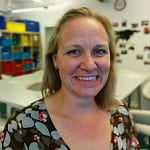by Dr Yvette Pyne, Academic Clinical Fellow, Centre for Academic Primary Care, University of Bristol
The breadth of conditions doctors are expected to manage continues to grow as people and society become ever more complex and it is in GP surgeries up and down the country where this is most starkly seen. The volume of work expected of GPs is taking its toll on individual doctors and the service as a whole.
My previous career designing and developing information technology (IT) systems gives me insight into the huge potential computers and machine learning have to help us in this increasingly challenging environment. Artificial Intelligence (AI) can enable us to provide the best evidence-based medicine to our patients while also freeing us from mundane administration to spend more time connecting with the human beings in front of us.
In the UK, Primary Care is already leading the way when it comes to the use of IT in our daily work. New business start-ups such as Babylon Health show how much further the boundaries can be pushed, with their attempts to employ AI technology in diagnosis and management. Matt Hancock, the current health secretary, is keen for technology to be used in the NHS to ease the pressures on an increasingly under-resourced system.
For technology to truly assist with, and perhaps even replace, some clinicians’ work on the frontline, we must understand what information the system is being given and how it is being processed. This is the role of health data science. Health data science combines maths, statistics and technology to help us to better understand diseases and conditions and can provide new ways of treating them or spotting them earlier.
As a GP Academic Clinical Fellow with one of the National Institute for Health Research (NIHR) themed posts related to health data science, I was invited to London to the launch of a new research collaboration between NIHR and Health Data Research UK (HDR UK). The aim of the day was to promote not only a relationship between the two research entities but between the clinicians, data scientists, and statisticians who have different skill sets to bring to the complex puzzle of managing patient data. Exciting research projects were discussed and speakers from across the country presented their work and their goals to an engaged audience.
Professor Colin McCowan, Professor of Health Data Science at St. Andrews University, discussed the HDR UK National Multimorbidity Platform, which is grappling with the issue of linking disparate datasets across multiple areas of health data. Not only is accessing and extracting the data complex, but overlapping datasets need to be harmonised and standardised. Governance of these datasets also needs to be thought through carefully given their scope and the sensitivity of the data.
Dr Rashmi Patel, an HDR UK fellow, showcased his work using Natural Language Processing (NLP) to ‘read’ complex and extensive clerking notes of psychiatric patients, teasing out the mesh of symptoms they describe and how these do (or in some cases perhaps do not) overlap with the patient’s formal diagnosis. His project demonstrated the complexity of extracting and analysing ‘fuzzy’ data from even more complex real people.
Professor Simon Ball, Executive Medical Director for University Hospitals Birmingham, discussed with me the Trust’s recent decision to trial an implementation of Babylon Health AI technology to run a pre-hospital triage service. The software has already proved controversial with doctors over concerns about how it seems to mis-diagnose life-threatening symptoms. However, Professor Ball wondered if perhaps bold and innovative choices such as these are the only option available when services are already stretched to their limits.
Health data science is an exciting area of research that can only work as a collaborative effort, as no individual has all the skills needed to deliver meaningful research on their own. There are also benefits and risks associated with private enterprise taking the lead. Researchers and frontline clinicians will have to find an appropriate balance between the commercial attitude towards innovation of ‘Move Fast, Break Things’ and the more traditional academic attitude of careful, sometimes years-long, thorough peer-review and publication process.
Whatever the future holds, it’s clear that this research area is only just getting started and is here to stay.

